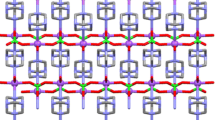Abstract
Crystal chemical features of some complex oxide lithium-containing compounds, in particular, triple molybdates, are considered to reveal the structure-forming significance of lithium. Its role is actually reduced to the realization of structures with a simpler composition through the introduction and heterovalent substitution. Specific stabilization ways can be very diverse owing to the high adaptability of lithium atoms in the structure. They can reside in the same crystallographic positions together with alkali metals (including potassium), medium-size, and even larger two- and three-charged cations and also to occupy the cavities. Such an adaptability and a low charge of the Li+ ion with its appropriate distribution in the structure allow the elimination of imbalance in cation charges and sizes of their coordination polyhedra. They also provide the filling of available vacancies, which produces a significant stabilizing effect. The stabilization of the structures with other cations or their combinations is exemplified. Attention is drawn to the relation between the structural and thermal stabilization. It is concluded that the crystal chemical stabilizing features of lithium and other cations can be used as an instrument for the design of novel compounds and materials.
Similar content being viewed by others
References
A. A. Blistanov, Crystals of Quantum and Nonlinear Optics [in Russian], MISIS, Moscow (2000).
C. Jousseaume, A. Kahn-Harari, D. Vivien, et al., J. Mater. Chem., 12, 1525 (2002).
A. Bensalah, Y. Guyot, M. Ito, et al., Optical Mater., 26, 375 (2004).
E. V. Makhonina, V. S. Pervov, and V. S. Dubasova, Chemistry Advances, 73, 1075 (2004).
Yu. A. Pyatenko and N. M. Chernitsova, Izv. Akad. Nauk SSSR, Ser. Geol., No. 4, 67 (1990).
M. J. Buerger, Am. Miner., 39, 600 (1954).
C. T. Li, Z. Kristallogr., 138, 216 (1973).
H. Schulz and V. Tscherry, Acat Crystallogr., B28, 2168 (1972).
A. Manthiram and J. B. Goodenough, J. Solid State Chem., 71, 349 (1987).
V. K. Trunov, A. A. Evdokimov, T. P. Rybakova, and T. A. Berezina, Zh. Neorg. Khim., 24, 168–171 (1979).
E., Lukacevic, A. Santoro, and R. S. Roth, Solid State Ionics, 18/19, Part 2, 922 (1986).
S. C. Abrahams and J. L. BernsteiNo, J. Chem. Phys., 45, 2745 (1966).
S. P. Sirotinkin, A. N. Pokrovskii, and L. M. Kovba, Kristallographiya, 26, 385 (1981).
S. P. Sirotinkin, A. N. Pokrovskii, and L. M. Kovba, Zh. Neorg. Khim., 21, 789 (1976).
G. Torres-Trevino, E. E. Lachowskii, and A. R. West, J. Mater. Sci. Lett., 5, 615 (1986).
N. Krishnamachari and C. Calvo, Acta Crystallogr., B29, 2611–2613 (1973).
A. P. Tyutyunnik, V. G. Zubkov, L. L. Surat, and B. V. Slobodin, Zh. Neorg. Khim., 49, 610 (2004).
S. F. Solodovnikov, E. G. Khaikina, Z. A. Solodovnikova, et al., Dokl. Ross. Akad. Nauk, 416, 60 (2007).
R. F. Klevtsova, L. P. Kozeeva, and P. V. Klevtsov, Kristallografiya, 19, 89 (1974).
O. M. Basovich, E. G. Khaikina, S. F. Solodovnikov, and G. D. Tsyrenova, J. Solid State Chem., 178, 1580 (2005).
D. Yu. Naumov and E. V. Boldyreva, J. Struct. Chem., 40, No. 1, 86–93 (1999).
I.I. Kiseleva, M. I. Sirota, R. I. Ozerov, et al., Kristallografiya, 24, 1277 (1979).
N. M. Kozhevnikova and M. V. Mokhosoev, Triple Molybdates [in Russian], Izd-vo BGU, Ulan-Ude (2000).
R. F. Klevtsova, L. A. Glinskaya, V. I. Alekseev, et al., J. Struct. Chem., 34, No. 5, 789–793 (1993).
R. F. Klevtsova, A. D. Vasiliev, L. A. Glinskaya, et al., ibid., 33, No. 3, 443–447 (1992).
V. A. Morozov, B. I. Lazoryak, V. A. Smirnov, et al., Zh. Neorg. Khim., 46, No. 6, 977 (2001).
S. F. Solodovnikov, P. V. Klevtsov, L. A. Glinskaya, and R. F. Klevtsova, Kristallografiya, 32, 618 (1987).
M. Müller,. B. O. Hildmann, and Th. Hahn, Acta Crystallogr., C43, 184 (1987).
Z. A. Solodovnikova, S. F. Solodovnikov, and E. S. Zolotova, ibid., C62, 16 (2006).
Z. A. Solodovnikova, Phase Formation and Structure of Triple Molybdates and Related Compounds in Systems Li2MoO4-A2 +MoO4-M2+MoO4 (A+=K, Rb, Cs; M2+=Mg, Mn, Co, Ni, Zn) [in Russian]: Avtoref. Diss. Kand. Khim. Nauk, Novosibirsk (2008).
E.G. Khaikina, Synthesis, Characteristics of Phase Formation and Structure of Double and Triple Molybdates of Uni- and Trivalent Metals [in Russian], Avtoref. Dis. … Dokt. Khim. Nauk, Novosibirsk (2008).
S. C. Abrahams, J. Chem. Phys., 46, 2052 (1967).
Z. I. Khazheeva, M. V. Mokhosoev, N. N. Smirnyagina, et al., Dokl. Akad Nauk SSSR, 284, 128 (1985).
F. D’Yvoire and E. Bretey, Solid State Ionics, 28–30, 1259–1264 (1988).
N. V. Belov, Outlines on Structural Mineralogy [in Russian], Nedra, Moscow (1976).
N. M. Kasper, Inorg. Chem., 8, 1000 (1969).
E. J. Cussen, and T. W. S. Yip, J. Solid State Chem., 180, 1832 (2007).
V. Thangadurai, H. Kaack, and W. J. F. Weppner, J. Am. Ceram. Soc., 86, 437 (2003).
E. V. Murashova, Yu. A. Velikodnyi, and V. K. Trunov, J. Struct. Chem., 29, No. 4, 648–650 (1988).
L. P. Keller, G. J. McCarthy, and R. J. Garvey, Mater. Res. Bull., 20, 459 (1985).
A. I. Tursina, V. A. Efremov, Yu. M. Gasanov, and V. K. Trunov, Kristallografiya, 35, 625 (1990).
S. F. Solodovnikov, P. V. Klevtsov, and R. F. Klevtsova, ibid., 31, 440 (1986).
B. I. Lazoryak, Usp. Khim., 65, 307 (1996).
Author information
Authors and Affiliations
Corresponding author
Additional information
Original Russian Text Copyright © 2009 by S. F. Solodovnikov, E. G. Khaikina, and Z. A. Solodovnikova
Translated from Zhurnal Strukturnoi Khimii, Vol. 50, Supplement, pp. S85–S92, 2009.
Rights and permissions
About this article
Cite this article
Solodovnikov, S.F., Khaikina, E.G. & Solodovnikova, Z.A. Stabilizing role of lithium in structures of complex oxide compounds as an instrument for crystal chemical design. J Struct Chem 50 (Suppl 1), 78–85 (2009). https://doi.org/10.1007/s10947-009-0193-x
Received:
Published:
Issue Date:
DOI: https://doi.org/10.1007/s10947-009-0193-x




